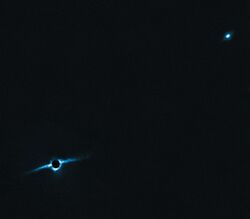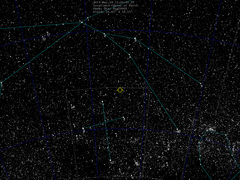Astronomy:HD 106906
| Observation data Equinox J2000.0]] (ICRS) | |
|---|---|
| Constellation | Crux |
| Right ascension | 12h 17m 53.191430s[1] |
| Declination | −55° 58′ 31.8904″[1] |
| Apparent magnitude (V) | 7.80[2] |
| Characteristics | |
| Spectral type | F5 V[3] |
| B−V color index | 0.458±0.003[2] |
| Astrometry | |
| Radial velocity (Rv) | +10.2±1.7[2] km/s |
| Proper motion (μ) | RA: −39.014[1] mas/yr Dec.: −12.872[1] mas/yr |
| Parallax (π) | 9.6774 ± 0.0429[1] mas |
| Distance | 337 ± 1 ly (103.3 ± 0.5 pc) |
| Absolute magnitude (MV) | 2.99[2] |
| Details | |
| Radius | 2.03+0.11 −0.10[1] R☉ |
| Luminosity | 6.56±0.04[1] L☉ |
| Temperature | 6,484+157 −168[1] K |
| Metallicity [Fe/H] | −0.04±0.08[2] dex |
| Age | 13±2[4] Myr |
| Other designations | |
| Database references | |
| SIMBAD | data |
HD 106906 is a binary star[6] system in the southern constellation of Crux. It is too faint to be visible to the naked eye, having a combined apparent visual magnitude of 7.80.[2] The distance to this system is approximately 337 light years based on parallax, and it is receding from the Sun with a radial velocity of +10 km/s.[2] It is a member of the Lower Centaurus–Crux group of the Scorpius–Centaurus OB association of co-moving stars.[4]
This is a double-lined spectroscopic binary system consisting of two F-type main-sequence stars with similar masses and a matching stellar classification of F5 V.[6] Their orbital period is less than 100 days.[4]
Planetary system

A distant circumbinary planet—HD 106906 b—is orbiting the pair at a projected separation of 732±30 astronomical unit|AU with a period of at least 3,000 years. An infrared excess around the binary is coming from a circumstellar debris disk that is being viewed edge-on. This has a pronounced asymmetrical shape, extending 120 AU on the east side and out to 550 AU to the west.[4] Planetary orbit is inclined to the debris disk by 39+20−15 degrees, and planet itself is visible nearly pole-on, having a large axial tilt.[7]
| Companion (in order from star) |
Mass | Semimajor axis (AU) |
Orbital period (years) |
Eccentricity | Inclination | Radius |
|---|---|---|---|---|---|---|
| debris disk | 65–550 AU | 84.65±0.35° | — | |||
| b | 11±2 MJ | ~2600 | >3000 | — | 64° | — |
References
- ↑ 1.0 1.1 1.2 1.3 1.4 1.5 1.6 1.7 Brown, A. G. A. (August 2018). "Gaia Data Release 2: Summary of the contents and survey properties". Astronomy & Astrophysics 616: A1. doi:10.1051/0004-6361/201833051. Bibcode: 2018A&A...616A...1G. Gaia DR2 record for this source at VizieR.
- ↑ 2.0 2.1 2.2 2.3 2.4 2.5 2.6 Anderson, E.; Francis, Ch. (2012), "XHIP: An extended hipparcos compilation", Astronomy Letters 38 (5): 331, doi:10.1134/S1063773712050015, Bibcode: 2012AstL...38..331A.
- ↑ Houk, Nancy; Cowley, A. P. (1979), Michigan catalogue of two-dimensional spectral types for the HD stars, 1, Ann Arbor, Michigan: Dept. of Astronomy, University of Michigan, Bibcode: 1978mcts.book.....H.
- ↑ 4.0 4.1 4.2 4.3 Rodet, L. et al. (June 2017), "Origin of the wide-orbit circumbinary giant planet HD 106906. A dynamical scenario and its impact on the disk", Astronomy & Astrophysics 602: 15, doi:10.1051/0004-6361/201630269, A12, Bibcode: 2017A&A...602A..12R.
- ↑ "HD 106906". SIMBAD. Centre de données astronomiques de Strasbourg. http://simbad.u-strasbg.fr/simbad/sim-basic?Ident=HD+106906.
- ↑ 6.0 6.1 Lagrange, A. -M. et al. (February 2016), "A narrow, edge-on disk resolved around HD 106906 with SPHERE", Astronomy & Astrophysics 586: 6, doi:10.1051/0004-6361/201527264, L8, Bibcode: 2016A&A...586L...8L.
- ↑ Bryan, Marta L.; Chiang, Eugene; Morley, Caroline V.; Mace, Gregory N.; Bowler, Brendan P. (2021), "Obliquity Constraints on the Planetary-mass Companion HD 106906 b", The Astronomical Journal 162 (5): 217, doi:10.3847/1538-3881/ac1bb1, Bibcode: 2021AJ....162..217B
- ↑ Kalas, Paul G. et al. (2015), "Direct Imaging of an Asymmetric Debris Disk in the Hd 106906 Planetary System", The Astrophysical Journal 814 (1): 32, doi:10.1088/0004-637X/814/1/32, Bibcode: 2015ApJ...814...32K
 |


